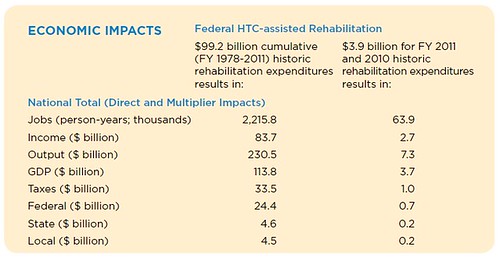by Michael R. Allen
Congress first authorized the federal historic tax credit for fiscal year 1978 in order to provide a return of 20% of the qualified expenditures of rehabilitating historic buildings to developers whose projects produced income. In creating the program, Congress recognized both the needs of older towns and cities with aging historic buildings — passed over by decades of federal mortgage guarantees that sucked wealth out to suburbs — and the demands of a nation facing high costs of energy and the limits of natural resource depletion, which could turn to its existing buildings.
The Historic Tax Credit Coalition’s Third Annual Report on the Economic Impact of the Federal Historic Tax Credit, released this month, reports that the program has been a success. Between fiscal year 1978 and fiscal year 2011, $99.2 billion has been invested in historic buildings. Over 2,200 jobs have been created due to the program’s stimulation of construction work and materials fabrication — not to mention its sustenance of professions including architecture, finance and law. One of the figures from the report shows the huge, positive impact on the program since its creation and just in the last two fiscal years alone.

The federal historic tax credit’s use provided a boost to Missouri’s economy as well. According to the report, in fiscal year 2011 the program led to $368 million of investment in Missouri. That investment created 2,500 jobs and $163.2 million labor income amid a recession that has seen a slowing of new construction. Coupled with Missouri’s model state historic rehabilitation tax credit, the federal historic tax credit is a jobs leader for the state — and a mechanism that has led to resource conservation, historic preservation and retention of sense of place.

One reply on “Federal Historic Tax Credit Led to $3.9 Billion in Investment in Last Two Years”
Re: the title. Which is why every effort has been made to try to eliminate/reduce it and other tax credits which aid older and/or urban cities. Credits and subsidies–both direct and indirect, such as allowing fracking companies to operate with scarcely any scrutiny from state and federal agencies–for major supranationals: full speed ahead.